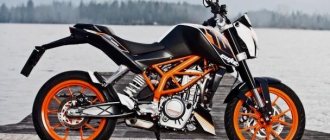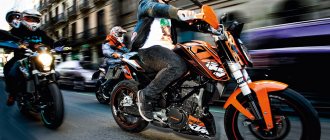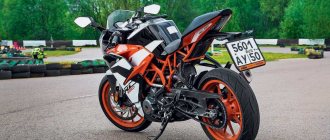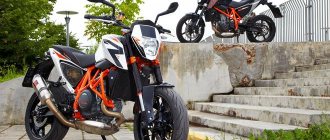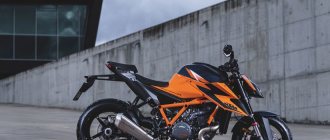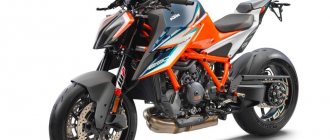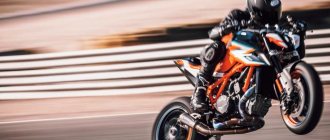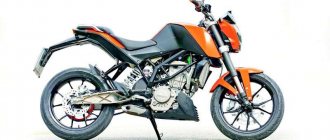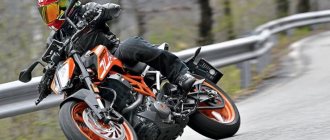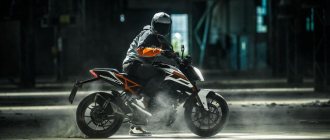The key of the KTM Duke 200 is quite simple compared to its Chinese competitors with shiny factory buttons. In terms of filling, alas, it is also empty - the KTM does not have an anti-theft immobilizer. But what a fun keychain!
When you have a choice, the main thing is to decide. And in order to decide, you need to understand what to guide. What should you look for when choosing a motorcycle if you are a beginner? I think that many grief-stricken bikers will wisely recommend a lightweight, small-capacity and reliable bike. Perhaps, these factors today correspond to more than one hundred different models of different brands. But if you don’t want to get involved with consumer goods or are generally a fan of “orange” cars, then our experimental Duke 200 is just what you can pay attention to, if only because it costs not much more than the “Chinese”, with which it has become the norm to compare when choosing first motorcycle. In addition, there is fuel injection, an inverted fork, a screwed-up instrument panel, LEDs, an interesting design and other bells and whistles - all this eliminates most of the competitors.
This kid has plenty of brutality, and the genes of his older brothers are clearly visible in the style. Tea is not “Chinese”
So many bells and whistles and yet such an affordable price? There must be a catch somewhere. And he is! The fact is that Duke's younger brothers are going to India. And this, to put it mildly, is alarming. Therefore, we decided to scrutinize it and find out what it really is: Indian or Austrian? In addition, it is built on the same chassis as the 125th and 390th versions. So, after studying it, you can get to know the brothers in absentia.
The stern is short and light in a modern way, and the mudguard honestly fulfills its function.
There’s no way to call a motorcycle handsome, and that’s true. Nevertheless, it definitely attracts attention, because in this ugliness one can sense a strong breed. KTM has probably never been distinguished by a glamorous wrapper - brutality and angularity are more to the liking of the designers of the Austrian brand. However, me too. This style is designed for an amateur, so the KTM brand has its own circle of inveterate fans, just admirers and, of course, opponents. KTM deals with the latter on race tracks, mostly off-road. But we haven’t had a chance to try yet how the asphalt KTM will behave.
The cage frame looks solid, the technological design of the rear swingarm is something special. It feels very light, and the imitation truss in the cavities inspires confidence in its rigidity and strength. The WP monoshock has no settings or lever system, only spring preload. Everything is simple and reliable. The front suspension is also without any adjustments, but the fork is of an inverted type, and also from WP. Well, the chassis is quite well equipped for this class of motorcycle. In general, the motorcycle is designed very reassuringly - it’s even visually clear that the entire center of mass is arranged around the engine. Almost all the electronics are under the false tank, and the exhaust system is very ergonomically “sucked” behind the engine. In its depths, by the way, there is also a catalyst. The compact radiator is neatly covered at the edges with plastic covers, the original “plow” from below looks excellent and fits logically into the overall picture, and the tail section is short and thin in a modern way. The stern is completed by an almost half-meter plastic mudguard (also known as a license plate holder), which weighs almost nothing. The battery is located under the front seat, and there is also an air filter and intake pipe - maintenance promises to be painless and quick.
From the side you can visually assess the location of the center of mass; moreover, nothing sticks out or sticks out. Duke 200 looks very neat and collected
Brakes are a different story. They are from ByBre (By Brembo), that is, in fact, real Brembo, only for small-capacity motorcycles and mopeds that are supplied to developing countries. At first glance, you can trust the four-piston caliper at the front and the single-piston caliper at the rear, and the brake hoses are reinforced. Let's see how they perform on the road.
The wheels are also of an original design: thin spokes resemble the shape of the rays of car wheels from the German company BBS. The tires are modest in size - 110/70 R17 at the front and 150/60 R17 at the rear, made in India, but they feel and look quite decent. I hope the quality of road grip will not leave much to be desired. In addition, small tires significantly lighten the wheel, and this, in turn, consumes less specific power, and accordingly more engine energy is transferred to the road surface.
We take a closer look at the Duke 200. The build quality and paintwork of the motorcycle are very good, although there were concerns about the production of the Duke in India.
1 / 8
The ByBre brakes turned out to be very grippy. Especially the front ones. Our version was without ABS - in this case, beginners will have to get used to measuring the force when braking, because even at low speed the wheel locks instantly
The rear swingarm is cool, despite the simplicity of its design
The muffler is located in a better place, however, the exhaust sound is not serious
Cage frame is a signature feature of all Duke motorcycles
Naked in all its glory - Duke's guts are open to all winds
Indian manufacturers can only be reprimanded for this carelessness - they could hide the connectors with wires
1 / 8
Duke's lighting equipment is quite sophisticated. Everything except the headlight is LED, even the license plate light on the mudguard. The turn signals and brake lights are clearly visible even on a bright sunny day. By the way, the headlight lights up automatically after starting the engine, this allows you to save the battery and not violate traffic rules due to forgetfulness. I had a chance to check the light in the evening. Pleased! The low and high beams shine decently, there was no desire to stuff xenon into the headlight. Although modern LED lamps, which, however, are also expensive, can improve factory performance. We discovered another feature in the evening: all the icons on the switches are illuminated from the inside, which is something you rarely see on a motorcycle.
I really liked the handles on the stern. Quite convenient both for a passenger with moderate dimensions (I think around 80 kg) and for rolling the motorcycle from place to place. If there were such powers, I would make these handles mandatory for all motor vehicles.
The sophisticated instrument panel deserves a separate story - few “adult” bikes can boast of such functionality. Even the integrated turn signal icon does not overshadow the impression; it is clearly visible from the driver’s seat, so when you ask “where is it blinking?” will not happen. There is a blinker (or shift-light - a signaling device for changing gears), a neutral signal is on and there is a high beam indicator. If there is a problem in the injection system, the red light at the top will light up. Yes, there is a scattering of indicators here! Among the shortcomings, I note that the dashboard glass glares in the sun, and this, of course, is annoying during the day. However, this drawback is present on all naked bikes. But there is a light sensor, therefore, the tidy itself begins to illuminate with a pleasant orange light.
1 / 9
The headlight comes to life with the turn of the ignition key after starting the engine
The rest of the lighting equipment is based on diodes
It may seem that the Duke's tank is of a respectable size, like a sportbike. However, no. The visual deception is achieved by using plastic on top of the 11-liter container
The expansion tank with antifreeze was very successfully hidden under the false tank
The switch icons on the steering wheel are illuminated from the inside - cool!
The tidy is perfectly readable in the dark, but during the day it all depends on the angle of incidence of the sun's rays
We must especially thank the manufacturer for the comfortable handrails on the tail of the motorcycle.
There is a small compartment under the passenger seat that can be locked with a key. The fuse box is located in it - very convenient. There is also a small set of standard tools, and there is still a little space left for small things.
1 / 9
The tidy provides the rider with all the necessary information. Look at the wealth of data output:
- tachometer
- speedometer
- odometer
- two daily mileage counters, trip duration (reset to zero after 60 minutes of parking without moving)
- fuel level in tank
- average fuel consumption
- instant fuel consumption
- range until next refueling
- coolant temperature
- watch
- engaged gear
- average speed
- remaining until next maintenance
- engine overheat warning
- message about lack of engine oil
- warning about voltage drop in the on-board network
- footrest extended warning
Now about the ride quality and feel. We started the engine and immediately a smile crept across our face. And not only for me. I’m sure even the girl you approach with this device will be slightly bewildered. The sound of the engine and exhaust is reminiscent of either the Soviet Voskhod or Minsk, provided that all the internals have been removed from the silencer and the noise level has been reduced by a factor of twenty. As a result, the KTM sounds like a moped started up in a large tin can, so advice: with a girl, start the moped last, when she is already seated in the back seat. Yes, there was certainly some disappointment because of this. The ignoble sound can even be regarded as an insult to the Duke with such a greyhound design and technology. True, there is a way out of the situation - buy an expensive tuned muffler created specifically for this motorcycle, and everything will sound differently. But this is for the fans. And what we have is what we have. We came to terms with it and even began to get used to it.
Fast turns at 100 km/h - easy! Enjoy sharp turns at lower speeds!
As we pulled away, I appreciated the decent traction at the bottom. Despite the small cubic capacity, you can get going by slightly adding speed, no throttle shifting or clutch weed. But this only happens in first gear. When you click the box higher, the small cubic capacity is still felt and the engine asks for more revolutions. I also discovered that the rows in the box are very close together, meaning the gears are very short. For example, at a distance of 150–200 meters, you can change all six gears and roll into sixth without straining at a speed of 60 km/h. Of course, it won’t be possible to accelerate decently in sixth from sixty, but it goes. At first, this constant switching was a little annoying. Changing the speed within 10–20 km/h requires changing gears up or down. Of course, the engine speed range is quite high, almost 11,000 rpm, and it is not necessary to shift so often, but we did not torture the unrun-in motorcycle, especially since before the break-in, the shift-light begins to loom already at around 7,000. For a high-speed test, we We have a used Duke 200 in our stash, and we’re trying to drive this one calmly, that is, the way we drive it to work every day. At the same time, in sixth gear, within the permitted speed limits of an untested engine, you can drive at speeds of up to a hundred. The motorcycle is very light and balanced, it turns into corners with a bang. Squeezing through traffic does not cause any trouble, and even encourages you, because not only motorists, but also owners of large motorcycles can wipe away their drool.
After riding around the city in this mode, you begin to enjoy complete control over the motorcycle, and the constant tugging of the box even turns into a thrill. A real motorcycle school, by the way. For beginners, driving a Duke will be an invaluable experience: the clutch is soft and informative, the brakes are simply excellent, the doses are very predictable, you can easily learn how to do “stoppies”! At the same time, we tested the brakes in semi-combat mode, warming them up with constant braking after acceleration. After half an hour, when we were pretty tired of it, the brakes got hot and began to weaken. In real life, they are unlikely to encounter such operating conditions, so there is no doubt about their reliability.
A week later, armed with a broken-in bike, we begin to experience maximum acceleration, revving the engine to the cutoff. And the Duke 200 pleasantly surprised us again. The fact is that at 7,000 rpm (at the mark when we switched up the gear on the new model), the experienced one let us feel all the salt of the two hundred cc engine. At seven thousand the engine opens and starts driving! The traction is confident, and the sound becomes more solid. You just want to push it further, and the already familiar motorcycle seems to have been transformed and become a class higher. True, the factory rev limit ends at just above 10,500 rpm. And at this moment you realize that the potential of the two hundred has not been fully revealed. Knowledgeable people claim that the rev limiter can be increased to 13,000. In our case, the motorcycle with factory parameters could not be accelerated above 137 km/h. No matter how hard I try. Although, to be honest, at speeds above 100 km/h you turn into a sail, and driving is no longer as enjoyable. The most relish is to move in the flow, keeping the tachometer not lower than the middle. In this mode, both the pickup and the sound of the motorcycle are simply a song. And the maneuverability is such that you want to hit your knees at every turn. And Indian rubber turned out to be quite tenacious. Even an experienced rider can find his limit, and the Duke still has some grip left. Acceleration is smooth and predictable. So opening the gas before entering a bend is a revelation! Yes, he provokes hooliganism on the road, damn it!
Having accelerated on the Duke, it’s easy to feel like a sail - the motorbike is still too small. And if you lie down on the tank, you feel like... an idiot
Of course, we should not forget that the wheelbase of this motorcycle is a bit short, and aggressive riding can provoke steering vibrations, to which the Duke 200, frankly speaking, is predisposed. If you plan to drive recklessly, do not skimp on purchasing a steering damper.
What about the expense? In city mode and heavy traffic for 100 kilometers, the Duke 200 sucked 3.4 liters of 95-grade fuel from the tank. The tidy at that moment convinced us that the motorcycle consumes an average of 3.8 liters per hundred. In fact, it turned out to be a little less.
Watering the Duke 200 day after day began to reveal its shortcomings. Firstly, the radiator pipe showed a couple of drops of antifreeze - they quickly fixed it by tightening the clamp. But most of all, the landing was annoying, or rather, it never became clear to me - this is the second thing. At first I thought: this is the engineer’s decision, and the fact that I am not entirely comfortable is a purely personal problem. Then he began to look more closely and noticed that the driver’s seat was slightly raised towards the stern. Sitting with my groin resting on the tank is not very comfortable for me, and the front wheel is overloaded. Moving all the way back, it becomes much more pleasant to drive the motorcycle, and the steering wheel with mirrors is in its place, but the sloping seat again forces you to slide back to the tank. It’s good that the material is non-slip and it’s not very difficult to stay in place. I found only one way out - get used to it.
By the way, the location of the footrests was also not entirely satisfactory. They seemed to be located a little far behind, but in the city it would have been more convenient, on the contrary, closer to the front. It turns out that the upper part of the body is located vertically, and the lower part is pulled back like a sportbike. In general, there is a flaw in the fit and you have to put up with it. At the same time, the narrow “waist” and protrusions on the tank provide decent support for the knees, for example, when braking. The steering wheel is a little narrow, but this is a definite plus in traffic. Highly raised mirrors provide good visibility. From a design point of view, I would lower them, but then constantly move my elbows to see something from behind. The build quality is good, all the panels fit neatly, nothing crunches or wobbles. True, the connectors and wires sticking out from under the tank were a little confusing; it could have been done more neatly, especially since there is enough space there.
The motorcycle left a more than good impression of itself. Here’s the thing: you don’t have any illusions about the civilian “200” and don’t expect to rush at full speed like one stung, this allows you to properly and objectively evaluate the dynamics - quite satisfactorily. Considering that the motorcycle is primarily for young people and beginners, this is enough. As a rule, the 125 gets boring quickly, and the 390 may be too powerful for a beginner. Of course, it’s hardly possible to dissuade a fool from a motorcycle with a liter or more, but if you approach the motorcycle theme wisely, then 200 cubic meters is the golden mean!
Summing up, it is worth noting that the Indian assembly provided more advantages than disadvantages. And, of course, the advantages relate not to the quality of the “cut”, but to the pricing policy. Probably, if the motorcycle had been produced in its homeland, in Austria, then some negative aspects might not have been present, but the selfish issue would have been much more acute. Therefore, our bow to the Indian has become more accessible.
Motorcycle KTM 200 Duke 2021
Looking at the KTM DUKE 200, you don’t immediately understand that this is a small-capacity vehicle, because visually it looks only slightly smaller than the Duke 690. In appearance, everything is balanced and neat: modern design, lean silhouette, strong suspension. The Duke 200 is essentially a grown-up Duke 125. Same design, same chassis and brakes, same wheels. But the engine added 10 hp, and at the same time the weight increased by only a couple of kilograms. The increase in power adds pep during acceleration, but the top speed hasn't increased by much. If the 125 confidently reaches 130 km/h, then the Duke 200 approaches 140 km/h, but at the same time you will have to sacrifice a comfortable vertical landing. The legs reach the ground, the landing is relaxed, everything is designed in such a way that even tall pilots will not rest their knees on the steering wheel. The weight of the motorcycle feels like that of an average mountain bike. And the handling, due to the short wheelbase, wide handlebars and low center of gravity, is exactly that of a bicycle. The steering wheel is simple, the handles are made of hard rubber and do not have weights, which is a definite plus when moving around the city. And the remote control buttons have a built-in backlight, which is rarely seen on adult motorcycles. It would be easier to describe what is not in it. At a quick glance, we see a good set of standard indicators: tachometer, speedometer, gear indicator, fuel level and engine temperature. It’s like “3 crusts of bread”, and to them... 2 daily mileage counters, average and instantaneous fuel consumption, consumption per 1 km, average speed readings and a lot of different warnings, and on top of all this there’s also a “blinker”! And all this is configured with two buttons: mode/set.
The motorcycle accelerates smoothly, calmly and confidently, like a subway train.
You hold the handle, the peak comes in a sporty way in the upper rev range, but it is barely noticeable. The speed reaches 130 and becomes constant. Now you can calmly maneuver in the flow, like a hooligan, changing lanes almost perpendicular to the movement. The Duke 200 comes equipped with WP suspension, which provides stability and precise handling. KTM suspensions have such an incredible reserve of strength that you can set any task before them! Complete and absolute confidence. The layout and concept of the Duke has long proven itself. And when the suspension and frame stiffness exceed the engine's potential, we get a completely controllable motorcycle. It can be tilted to the knee without fear. Simply put, you can learn the basics of sports driving. Moreover, even at the karting track you will have to use the gearbox competently in order to keep the engine in good shape all the time.
Liked:
- motorcycle design The exterior, of course, is not for everybody, but I like this type of naked bike - the Duke turned out stylish
- excellent chassis After the “200” we now want to try KTM sportbikes
- sophisticated electronics Despite the fact that the motorcycle falls into the category of affordable motorcycles for emerging markets, the electronics are like those of a bike of a higher class
- illuminated indicators on the switches A very nice and useful bonus for night trips
- grippy brakes sound like a fake, of course, but these are truly branded Bramb brakes. Stop the motorcycle just as confidently
- comfortable handles on the stern I will repeat once again: ideally, to see such handrails on every motorcycle!
Classmates
The Duke 200 has a myriad of competitors on the global market - from outright consumer goods to luxurious and expensive models. Given the rich technical content of the Duke 200, most of them are naturally eliminated. But, taking into account the specifics of the Kazakh market, it is Chinese models with engines up to 350 cc that pose a challenge. see. Such “Chinese” ones cost about $3,500. The Duke 200 in our configuration without ABS costs 890,000 tenge, or approximately $4,800. Would I prefer it to the “Chinese”? Definitely yes! And here’s why: firstly, the Austrian “200” drives no worse than the 350 cc Chinese one with similar fuel consumption. Secondly, the KTM technical stuff is much more solid. Yes, the car factory function and alarm system of motorcycles from the Middle Kingdom is, of course, cool, but believe me, bikers are not fooled by this kitsch. And thirdly, to the question: “What kind of motorcycle do you have?” - it’s much more pleasant to answer: “I have a KTM.” Agree, it sounds much more significant than if it were Lifan or some Yamasaki.
My rider: KTM Duke 250 review
“Kisa, let me ask you as an artist of an artist... Can you draw?” This year, the family of small single-cylinder Dukes received some serious updates. Having attended the Russian premiere of the family, we have already become acquainted with the Duke 390 and can safely say that the motorcycle is completely new, as are its younger 125 and 200 cc brothers. But where does the 250 fit in this family? Why is it needed and is this device worth considering? Let’s try to figure it out.
Unlike sports equipment, where the Austrians clearly build devices in accordance with the current competition regulations, on asphalt KTM traditionally rocks with cubic capacities: 200, 390, 1050, 1090, 1290... It seems that any coincidence with the real canons of a particular genre is accidental, company with all trying (admittedly, often successfully) to set the vector of development of the entire motorcycle industry, loves unusual solutions. And here you are wearing “two hundred letters.” Neither 290 nor 240 – exactly a “check”!
It’s unusual to see the 250 in the KTM model range, which traditionally stayed away from established classes
Apparently, the time has come to compete with the Asians like the Honda CBR 250, Kawasaki Z250, Yamaha MT-03 and other Suzuki GW250 in their field. It’s logical, because previously it was Japanese brands that became the golden mean between the Duke 200 and Duke 390. Moreover, the 250 has a number of budget solutions, thanks to which the device not only costs less, but also does not stand out too much in the segment. Ideal for Asian markets and certainly not bad for ours.
Specifications
| Motorbike | |
| brand, model | KTM Duke 200 |
| Production | India |
| Year of issue | 2014 |
| Type | naked |
| Frame | tubular steel spatial |
| Number of seats | 2 |
| Engine | |
| Type | petrol four-stroke DOHC |
| Supply system | injection system |
| Cooling system | liquid |
| Number of cylinders/valves | 1/4 |
| Working volume, cm cubic. | 199.5 |
| Maximum power, l. With. (kW)/rpm | 26 (19)/10 000 |
| Maximum torque, Nm/rpm | 20/8 000 |
| Transmission | |
| Drive unit | chain |
| Transmission | manual 6-speed |
| Suspension | |
| Front: travel, mm | inverted fork/150 |
| Rear: travel, mm | swing arm with monoshock absorber/150 |
| Brakes | |
| Front: size, mm | single disc, 300 |
| Rear: size, mm | single disc, 230 |
| Tires | |
| Front | 110/70 R17 |
| Rear | 150/60 R17 |
| Discs | light alloy |
| Dimensions and weight | |
| Ground clearance, mm | 170 |
| Seat height, mm | 800 |
| Wheelbase, mm | 1 367 |
| Dry weight, kg | 129.5 |
| Fuel tank volume, l | 11 |
